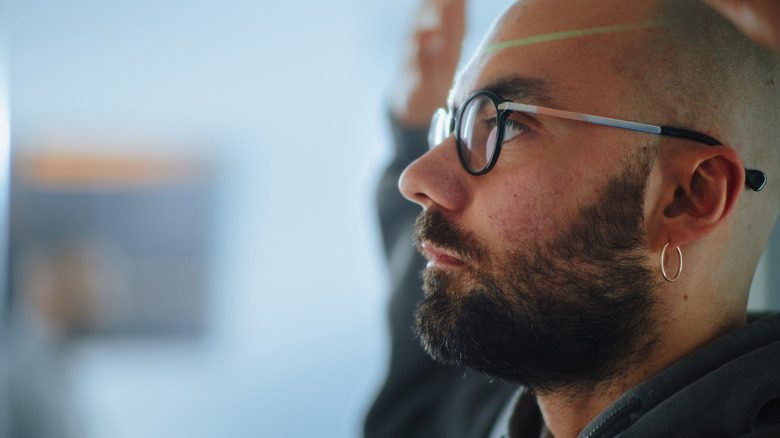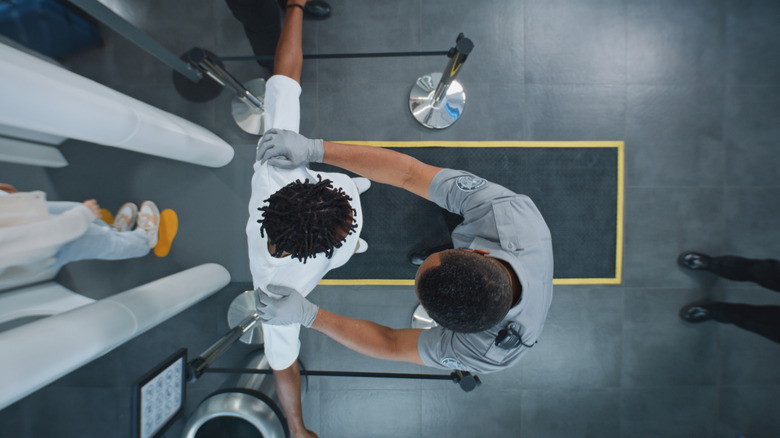The Common Body Feature That May Increase Your Chances Of Getting Flagged By TSA
Who doesn't love a good pat down from those oh so cheerful and kind people at the Transportation Security Administration (TSA)? It's almost like you're family when you pass through security, if "family" means the worst scum-of-the-earth criminal suspect whose little hand lotion bottle is definitely a nuke. Yes, we know: They're just doing their job and have been doing so since the post-9/11 terrorism scare days. And yes, airport security has caught some bizarre no-no items heading onto flights in 2024 alone, like a gun slipped into a stroller, live snakes inside some guy's pants, and meth in crutches. Other dastardly ne'er-do-wells just wear beards.
That's right. In a full-on case of unsubstantiated expertise meets unavoidable human bias, the TSA has it in for the bearded legions of the world. In 2003, Homeland Security started rolling out its "can you spot the shifty-eyed thought criminal?" program, aptly named Screening of Passengers by Observation Techniques (SPOT). In 2008, we got an official-looking Privacy Impact Assessment outlining the information that the TSA collects on people, complete with a fancy Homeland Security seal and sections meant to sound scientific, like "abstract." Then came the inevitable this-is-all-groundless-BS blowback in articles like that on The Intercept in 2015 and the equally inevitable rebranding of SPOT into the exhaustively named Behavior Detection Visual Search Task Analysis Project in 2018.
But you know what hasn't changed? Beards are still sus, as the kids would say. Even recently shaving one and leaving behind a paler patch on the lower half of your face is a red flag for the TSA.
To beard or not to beard: No is the answer
We might as well just dive into the tangled, bushy, possibly clipped and oiled details of the TSA's interest in hairy faces. But to be fair, beards are not directly called out on the now-defunct Screening of Passengers by Observation Techniques (SPOT) Referral Report. That document, leaked to The Intercept in 2015, contains 92 points of interest for would-be TSA terrorism vanquishers, broken down into three categories: 1 point (stress markers), 2 points (fear markers), and 3 points (deception markers). Meeting a criterion increases your score by the stated number of points. No word on when you hit bingo.
Highlights include "excessive yawning," being late, avoiding eye contact, having too much eye contact, having a "strong body odor" and sweaty palms, "fidgeting" and "clock-watching," keeping a "rigid posture," "display[ing] arrogance," and a whole ream of other criteria. Certainly, they have nothing to do with the innumerable stressors related to catching a flight, riding a metal death tube through the sky (you've probably heard about some of the deadliest plane crashes in history), or being scrutinized by the TSA. And right there in the 1-point and 3-point columns are two clues related to beards.
Respectively, they are "face pale from recent shaving of beard" and "appears to be in a disguise." The former is presumably suspicious because a bearded villain might want to go smooth to avoid detection. The latter is presumably suspicious because no one can tell that a fake beard or moustache is fake. Then there are between-the-lines testimonials like that on Beardbrand, whose Brooklyn-based writer endured prolonged TSA scrutiny for having a big, bushy beard and "appear[ing] as Middle Eastern."
The TSA comes under scrutiny
Like we mentioned, the TSA got lambasted for its phrenology-adjacent tsk-tsk passenger behavior detection list. It was apparently based on psychologist Paul Ekman's 1970's investigations into "microexpressions," i.e., tiny little gestures that supposedly crack the human psyche wide open if depuzzled correctly. But since people are so garbage at reading others, the whole TSA bad behavior program is borked.
In 2013, a Government Office of Accountability (GOA) report noted that there's just a 54% likelihood someone can detect a lie, i.e., barely better than random chance. It found that the whole initiative — beard suspicions included — is completely subjective, ascientific, used faulty metrics, led to racial and ethnic profiling, straight-up "cannot be used to identify threats to aviation security," and was not worth its nearly $1 billion price tag. Then, under the Freedom of Information Act (FOIA), the American Civil Liberties Union requested documents from the TSA related to racial profiling, the TSA refused, and the ACLU sued them. Then, the TSA forked over 16,000 pages, and the ACLU drafted a 2017 report (paraphrasing, here) calling the detection methods dumb, draconian, and useless.
But because human bias dies hard, if at all, bearded people take note: For your own sanctity of mind and travel itinerary, it's probably not a good idea to go full wizard with your beard. Trim it, manscape it before flying, and go with the handsome man beard model. Kemptness matters even if the great eye of the TSA isn't watching to see if you're a sneaky beard-wearer or if you've got snakes in your pants.


